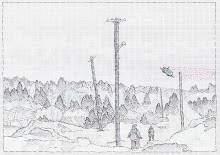
figure 1
This animal(fig 1) will disappear in the early 23rd century due to lack of habitat caused by poorly planted monoculture forests.

figure 2
This animal(fig. 2) will emerge in the late 23rd century in an unprecedented speciation event. Their small size will allow them to move freely in the cramped forest, enabling them to reach food sources. An almost total lack of predation(fig. 3) will allow them to reach huge numbers. They will be considered pests due to there interference with human activity(see img. 1 below).

figure 3

figure 4
This animal(fig. 4) is an engineered species which will be introduced in the mid 24th century with the intent of lowering the population of the animal pictured in figure 2(see img. 2 below). Over time they will be so effective at this that they will eliminate their primary food source and move on to other prey(see img. 3 below).

figure 5
This engineered species(fig. 5) will be introduced in the early 25th century to eliminate the population of the animal pictured in figure 4. They will prove to be very effective at this(see img. 4 below) and will prove to be docile, good natured animals in their interactions with humans.

figure 6
Unfortunately, the extreme engineered elements of the gene structure in the animal pictured in figure 5 will become recessive over generations of breeding in the wild. Causing them to be predisposed to chronic back and joint pain(fig. 6).

image 1

image 2

image 3
image 4

